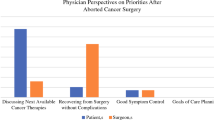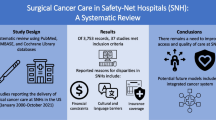Abstract
Purpose
Quality of care and its measurement represent a considerable challenge for pediatric smaller-scale comprehensive cancer centers (pSSCC) providing surgical oncology services. It remains unclear whether center size and/or yearly case-flow numbers influence the quality of care, and therefore impact outcomes for this population of patients.
Patients and Methods
We performed a 14-year, retrospective, single-center analysis, assessing adherence to treatment protocols and surgical adverse events as quality indicators in abdominal and thoracic pediatric solid tumor surgery.
Results
Forty-eight patients, enrolled in a research-associated treatment protocol, underwent 51 cancer-oriented surgical procedures. All the protocols contain precise technical criteria, indications, and instructions for tumor surgery. Overall, compliance with such items was very high, with 997/1,035 items (95 %) meeting protocol requirements. There was no surgical mortality. Twenty-one patients (43 %) had one or more complications, for a total of 34 complications (66 % of procedures). Overall, 85 % of complications were grade 1 or 2 according to Clavien–Dindo classification requiring observation or minor medical treatment. Case-sample and outcome/effectiveness data were comparable to published series. Overall, our data suggest that even with the modest caseload of a pSSCC within a Swiss tertiary academic hospital, compliance with international standards can be very high, and the incidence of adverse events can be kept minimal.
Conclusion
Open and objective data sharing, and discussion between pSSCCs, will ultimately benefit our patient populations. Our study is an initial step towards the enhancement of critical self-review and quality-of-care measurements in this setting.
Similar content being viewed by others
References
Fernandez CV. Our moral obligations in caring for patients with orphan cancers. CMAJ. 2007;176(3):297.
Vogelzang NJ, Benowitz SI, Adams S, Aghajanian C, Chang SM, Dreyer ZE, et al. Clinical cancer advances 2011: annual report on progress against cancer from the American Society of Clinical Oncology. J Clin Oncol. 2012;30(1):88–109.
Corrigan JJ, Feig SA; American Academy of Pediatrics. Guidelines for pediatric cancer centers. Pediatrics 2004;113(6):1833–5.
Kaatsch P. Epidemiology of childhood cancer. Cancer Treat Rev. 2010;36(4):277–85.
Somasundaram R, Herlyn D. Chemokines and the microenvironment in neuroectodermal tumor-host interaction. Semin Cancer Biol. 2009;19(2):92–6.
Michel G, von der Weid NX, Zwahlen M, Adam M, Rebholz CE, Kuehni CE, et al. The Swiss childhood cancer registry: rationale, organisation and results for the years 2001–2005. Swiss Med Wkly. 2007;137(35–36):502–9.
Matthay KK, Villablanca JG, Seeger RC, Stram DO, Harris RE, Ramsay NK, et al. Treatment of high-risk neuroblastoma with intensive chemotherapy, radiotherapy, autologous bone marrow transplantation, and 13-cis-retinoic acid. Children’s Cancer Group. N Engl J Med. 1999;341(16):1165–73.
Yu AL, Gilman AL, Ozkaynak MF, London WB, Kreissman SG, Chen HX, et al. Anti-GD2 antibody with GM-CSF, interleukin-2, and isotretinoin for neuroblastoma. N Engl J Med. 2010;363(14):1324–34.
Morse RB, Hall M, Fieldston ES, McGwire G, Anspacher M, Sills MR, et al. Hospital-level compliance with asthma care quality measures at children’s hospitals and subsequent asthma-related outcomes. JAMA. 2011;306(13):1454–60.
Dekutoski MB, Norvell DC, Dettori JR, Fehlings MG, Chapman JR. Surgeon perceptions and reported complications in spine surgery. Spine. 2010;35(9 Suppl):S9–S21.
Clavien PA, Barkun J, de Oliveira ML, Vauthey JN, Dindo D, Schulick RD, et al. The Clavien–Dindo classification of surgical complications: five-year experience. Ann Surg. 2009;250(2):187–96.
Lee HY, Cooke CE, Robertson TA. Use of secondary prevention drug therapy in patients with acute coronary syndrome after hospital discharge. J Manag Care Pharm. 2008;14(3):271–80.
Strother DR, London WB, Schmidt ML, Brodeur GM, Shimada H, Thorner P, et al. Outcome after surgery alone or with restricted use of chemotherapy for patients with low-risk neuroblastoma: results of Children’s Oncology Group study P9641. J Clin Oncol. 2012;30(15):1842–8.
Hall G, Grant R, Weitzman S, Maze R, Greenberg M, Gerstle JT. Predictors of surgical outcome in Wilms’ tumor: a single-institution comparative experience. J Pediatr Surg. 2006;41(5):966–71.
Koivusalo AI, Pakarinen MP, Rintala RJ, Saarinen-Pihkala UM. Surgical treatment of neuroblastoma: twenty-three years of experience at a single institution. Surg Today. 2013 .doi:10.1007/s00595-013-0576-7.
Wang TI, Wu PK, Chen CF, Chen WM, Yen CC, Hung GY, et al. The prognosis of patients with primary osteosarcoma who have undergone unplanned therapy. Jpn J Clin Oncol 2011;41(11):1244–50.
Hendershot E, Chang A, Colapinto K, Gerstle JT, Malkin D, Sung L. Postoperative fevers in pediatric solid tumor patients: how should they be managed? J Pediatr Hematol Oncol 2009;31(7):485–8.
Ehrlich PF, Ritchey ML, Hamilton TE, Haase GM, Ou S, Breslow N, et al. Quality assessment for Wilms’ tumor: a report from the National Wilms’ Tumor Study-5. J Pediatr Surg 2005;40(1):208–12 (discussion 12–3).
Wolff JE, Driever PH, Wolff B, Kramm CM, Kortmann RD, Pietsch T, et al. Pediatric neuro-oncology in small centers—quality control of network support: the HIT-GBM experience. Anticancer Res. 2011;31(2):661–4.
Acknowledgement
The authors would like to thank Dr. Emma Garcia for her help in data collection.
Disclosure
The authors declare that they have no conflicts of interest in this study, or any financial and personal relationships with other people or organizations that could inappropriately influence the work.
Author information
Authors and Affiliations
Corresponding author
Additional information
R. Renella and C. Gapany share the senior authorship.
Rights and permissions
About this article
Cite this article
Joseph, J.M., Farron, A.M., Renella, R. et al. Can Smaller-Scale Comprehensive Cancer Centers Provide Outstanding Care in Abdominal and Thoracic Pediatric Solid Tumor Surgery? Results of a 14-Year Retrospective Single-Center Analysis. Ann Surg Oncol 21, 1726–1731 (2014). https://doi.org/10.1245/s10434-013-3455-y
Received:
Published:
Issue Date:
DOI: https://doi.org/10.1245/s10434-013-3455-y




